(This is a continuation of a prior post that talked about winter walking gear from the waist down. This one focuses on the area from the waist UP, as well as accessories.)
I had the pleasure of attending a “Winter Walking” seminar hosted by Marathon Sports at their Cambridge location. This seminar was free and open to the public. I’m writing this in order to share the information I learned and to spread the love for local businesses – especially the running stores that keep us all on our feet. No compensation was requested or offered in exchange for this post, although I did use the 20% off discount they provided that night to those of us in attendance. Links to Amazon are provided only because Marathon’s online shop doesn’t carry all of the gear available in their store. Use these links as illustrative – and if you can buy from your local running shop, that’s the way to go.
If you break down the basics of walking as a sport – or just as general exercise – into the top-most categories, it really looks a lot like this:
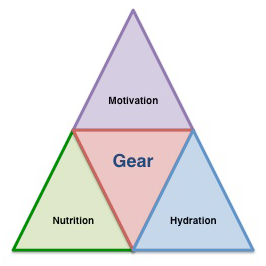
This post is going to focus specifically on GEAR for winter walking from the waist UP, as well as accessories. Part 1 focuses on gear from the waist DOWN. As I pointed out in Part 1, to learn more about what to do for gear in warmer times, check out the posts I wrote about gear for walking marathons (from my first marathon) or about how I geared up for my second walking marathon.
Fundamentals for walking/running in ANY season:
- Wear synthetic, wicking fabrics and DON’T WEAR COTTON
- Focus on FIT and FUNCTIONALITY
- Live in LAYERS
- Be VISIBLE
Moving from the waist on up…
Tops: Layer, layer, layer. Start with a base layer made from a synthetic, wicking material (such as Nike DRI-FIT or the awesome Craft base layer that I bought); tighter, more form-fitting shirts will tend to keep you warmer, but not everyone likes that style. Feel can also be somewhat important; my Craft shirt is incredibly soft–and that makes me far less likely to freak out about its body-hugging style.
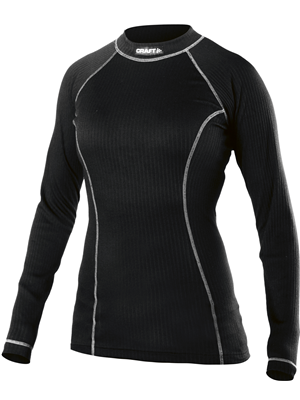
Craft Active Crewneck
Mid-layers, such as 1/4 or 1/2-zip shirts should also be made from synthetic, wicking material, and the zip allows you to ventilate somewhat if you start to find your layers too warm. The Saucony mid-layer that I bought is very comfortable, although in that 5ºF walk I referenced in Part 1 of this series, I was still somewhat chilly. Then again, let’s think about just how cold 5ºF is, and perhaps it makes sense. The Saucony top has those thumb holes that I adore, since they allow me to keep my wrists warmer while I’m walking, creating a better seal with my gloves or mittens. It also came with a rechargeable USB light (no batteries needed!), which my neighbor and I took for a spin on that rather cold morning.
While it may seem tempting to buy just a single heavy layer, such as a sweatshirt or thick fleece, these super-warm items don’t provide you with versatility and flexibility–features critical to success at all-year-round walking. The base and mid-layers allow you to take off or add on as you go, to help you regulate your temperature more easily.
Bras: Again – synthetic, wicking materials are key. The folks at Marathon recommended bras from Moving Comfort, a company they described as having many options and being well-regarded. They also noted that “your bra should never see a birthday”. (I chuckle as I write this, because I have sport bras that have seen more birthdays than my kids. Yeah, I need to buy new ones. Clearly.)
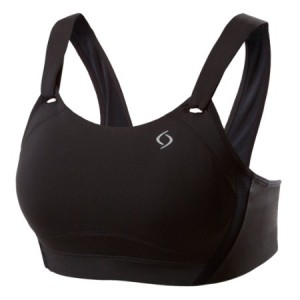
Moving Comfort Jubralee bra
I tried on several styles, including the highly recommended Jubralee, but the size selection at Marathon didn’t work for my awkward frame. That’s not any reflection of Moving Comfort’s product or Marathon’s selection; finding comfortable bras (whether for exercise or more formal purposes) is always very difficult for me. Still, it was easy to see that these were jogbras at a quality level I hadn’t seen; the good old shelf-bra was visible, but many of these higher-end bras have velcro-adjustable straps and adjustable fasteners for the bust line; some even have underwire (if you’re into that sort of thing). No matter how you go, just make sure it’s wicking, to reduce chafing and keep your temperature better managed.
Jackets: These go in lockstep with your layers. Marathon’s team emphasized the use of products with DWR (Durable Water Repellent), because the water really does flow right off them. Granted, if you stand in a monsoon at a soccer game (which I have done), eventually some of the rain will penetrate the jacket. However, if you’re on the move, such as a walk, that’s not as much of a problem. Aim for jackets that will work well with your base and/or mid-layer, and consider potentially important features, such as: water repellency, reflective striping, and thumb-holes. I went with the Saucony Nomad Jacket, which hits on the latter two of those three features; it’s also slightly less form-fitting than the New Balance Windblocker jacket
I also considered, giving me more room for layering.
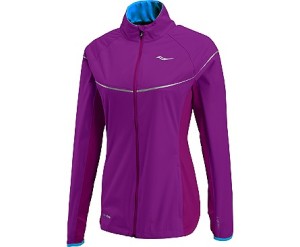
Saucony Nomad Jacket
Since I already have a great rain jacket, my purchase was more about cold weather management. Going back again to that 5ºF walk, I didn’t find that the base layer, mid-layer, and jacket were quite sufficient to keep my core as warm as it needed to be–but if I had added one more layer or bulked up to a warmer mid-layer, I think I would have found the arctic temperature more palatable.
Accessories: Technology has evolved aplenty to help keep you warm and visible while out on a walk, no matter what time of day or night. Touch-screen reactive gloves, like The North Face Etip gloves, enable you to fiddle with your smartphone without having to expose more skin in cold weather, and some hats, such as the clever one from TrailHeads that I bought
(above), cover your head with a warm, comfy fleecy beanie while still allowing an outlet for a ponytail. My head was toasty warm on my chilly walk, thanks to that TrailHeads hat!
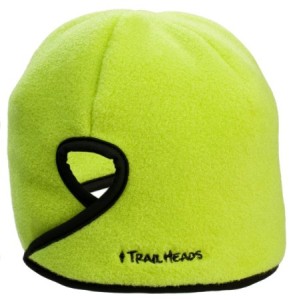
TrailHeads Goodbye Girl Ponytail Hat
In the darker parts of the day, keep yourself visible to cars by wearing knuckle straps, vests, singlets, and/or attachable lights (such as one that came with my Saucony mid-layer or the Nathan Hyper-Brite Strobe light
that DH bought me for Christmas). Given the shorter daylight hours and potentially snow or ice-covered walkways and sidewalks, winter walking often requires sharing the road with cars. It’s your responsibility to be visible, and even a small strobe can make a big difference.
Where to buy gear and accessories…
Depending upon your tolerance for returns, you can buy much of this gear wherever you find items that fit that ideal of synthetic, wicking, and NON-COTTON materials. That said, your local running store, like Marathon Sports, typically has a good selection of items that fit the bill appropriately, and that would ALWAYS be my first recommendation. Mass market sporting goods stores and discount department stores can offer less expensive gear – but the materials may not be of the right quality or fiber, literally. Of course, you can buy online…assuming, again, that you don’t mind the inconvenience of returns if an item doesn’t fit as intended.
(Next up: a separate post about how to save money on gear…!)
If you have other tips or gear that you want to share with others, please feel free to comment. The community of those who want to be or stay active is large and supportive. Now get out there and get walking!
